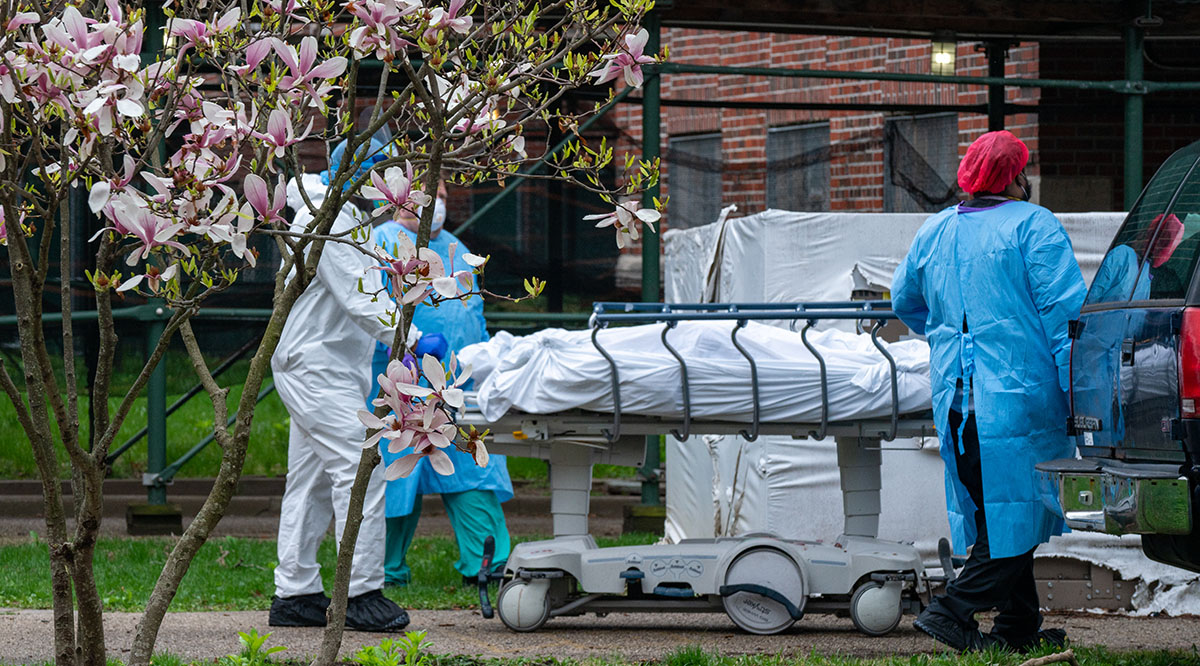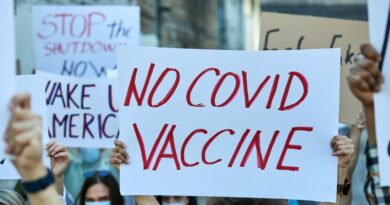How are COVID-19 deaths counted? It’s complicated

An elderly man arrived at Atlanta’s Emory University Hospital Midtown last month so stricken with advanced cancer that it could take his life within months — but that’s not what brought him to the emergency room.
The man had contracted COVID-19 and was struggling to breathe, recalls Sara Auld, MD, a critical care physician at the hospital. He was admitted to the intensive care unit (ICU) and intubated. “Given his already fragile state, his condition quickly took a turn for the worse” and he died, she recalls.
Was his death caused by COVID-19?
Yes, Auld says: “While he was very weak and frail from his underlying cancer, his death was undoubtedly accelerated and precipitated by COVID-19.”
Such decisions, made every day by doctors in hospitals around the country, are the unseen yet predominant sources for the nation’s most watched and scrutinized health statistic: people who have died from COVID-19.
The official government figure — nearly a half-million as of mid-February — has spurred not only public health measures to battle the disease but also confusion and doubts based on a fundamental question: What defines a COVID-19 death?
The answer can get complicated.
Early in the pandemic, some of the answers provided by public officials — who were scrambling to track the disease as it overwhelmed health systems — fed skepticism. Last April, Deborah Birx, MD, coordinator of the White House Coronavirus Task Force, said this when asked about people who have COVID-19 but die from preexisting conditions: “If someone dies with COVID-19, we are counting that as a COVID-19 death.”
That statement, combined with some state health officials saying they follow the same policy, sparked charges that the COVID-19 totals were inflated by deaths from other diseases and even auto accidents if the victims happened to have COVID-19. Federal and state governments gradually altered such policies over the spring and summer to say that in order for a death to be counted as a COVID-19 death, the disease had to have played a role.
Still, people wonder: What determines if COVID-19 played that role? Many people still doubt the official totals, with some claiming they’re inflated as part of a conspiracy.
Just recently, Auld says, she got an email from a relative “informing me that COVID death numbers were grossly exaggerated — that the CDC had intervened” to increase the totals.
“I blew my lid,” Auld says — but she vented only to her husband.
There’s no evidence of orchestrated inflation, but parsing the role that the disease plays in some deaths is not always easy for doctors — nor is the process clear to the public.
COVID-19’s complicated cascade
At the core of the issue is the fact that COVID-19 kills in myriad ways, typically setting off a combination of potentially fatal afflictions.
“COVID-19 can cause an extraordinarily wide range of clinical complications,” Auld says. “While pneumonia and respiratory failure are the most common manifestations, it can also cause blood clots, including strokes and heart attacks.”
When a COVID-19 patient dies, “it’s usually a cascade of events that lead to death — it’s not one thing,” agrees Daniel Handel, MD, MBA, MPH, chief medical officer for Indiana University Health’s South Central Region in Bloomington.
In addition, the disease’s brutal impact on people with other medical conditions — such as diabetes, hypertension, and heart ailments — can make COVID-19 one of several contributors to a death, says Sally Aiken, MD, chief medical examiner of Spokane County, Washington. Aiken has seen cases where elderly people who were in advanced decline due to Alzheimer’s disease and atrial fibrillation contracted COVID-19 and soon died.
When COVID-19 accelerates such a person’s death from other causes, is that a COVID-19 death?
The answer gets recorded on the main document behind the nation’s COVID-19 fatality count: the death certificate.
The death certificate process
Many people think of a death certificate as a precise final verdict. But often, the document reflects a judgment that weighs the roles of multiple conditions, taking into account a person’s medical history along with their most recent medical data and symptoms.
“There always have been cases where there are gray areas of death certification,” says Aiken, immediate past president of the National Association of Medical Examiners.
COVID-19 cases can paint lots of gray. In an instructional video for filling out death certificates in cases that might or might not be attributed to COVID-19, the Centers for Disease Control and Prevention (CDC) advises health professionals to “use your best clinical judgment.”
Here is how the process typically works:
Who fills out the certificate
When someone dies in a health care facility, the task of determining the cause usually goes to a physician who oversaw the person’s care or the person’s primary care doctor. Coroners and medical examiners make the determination in various other instances, including deaths that are unexpected, violent, or occur at home.
How death causes are recorded
Part I and II of a death certificate ask what caused a death and what other factors contributed to it. If COVID-19 appears among the causes and contributors, CDC guidance counts that as a COVID-19-related death.
Part I asks for the “immediate cause” of death, followed by any “conditions that led to the immediate cause,” the CDC explains in guidelines for certifying COVID-19 fatalities. For example: In some COVID-19 cases, the immediate cause is an affliction that arose from the disease, such as pneumonia, while COVID-19 gets listed under that as an underlying condition that led to death. In other words, COVID-19 caused the pneumonia.
Part II asks for conditions that did not set off medical events that led to death but contributed in some other way. Here, COVID-19 appears as sort of an accomplice to a fatality that was probably going to occur from something else (such as a preexisting, terminal disease), albeit later than if the person had not contracted COVID-19.
For instance: In Aiken’s example of a patient near death from Alzheimer’s disease before contracting COVID-19 (which she described as taken from several cases, not one in particular), COVID-19 would be a contributing condition, not a cause. “She was already in decline, had a short life expectancy, and COVID-19 may have tipped her over, but just barely,” Aiken says.
The Alaska Department of Health and Social Services explains on its website why the disease is cited if it played any role at all:
“Whether COVID-19 shortened a life by 15 years or 15 minutes; whether COVID-19 is an underlying or contributing condition, the virus was in circulation, infected an Alaskan, and hastened their death.”
Making decisions
COVID-19’s role in a death is perhaps most clear in an ICU. By the time COVID-19 patients get there, they are suffering severe symptoms of the disease and have probably tested positive for it.
“They might die from septic shock,” Auld says, referring to a faulty immune response that can cause tissue damage and organ failure and has been linked to COVID-19. “But when you go back to the reason they came to the hospital and got so sick, it’s COVID. If you go back to the root cause, it’s COVID.”
The assessment is often less clear in emergency departments. Some patients there are treated with no time to test them for COVID-19, notes Ali Raja, MD, MBA, MPH, executive vice chair of the Department of Emergency Medicine at Massachusetts General Hospital. Some do show obvious and severe COVID-19 symptoms or have a previous diagnosis of the disease.
“We put that [COVID-19]” on the death certificate in those cases, he says.
Others, however, have no COVID-19 symptoms or previous diagnosis. For those who die — from a heart attack, for instance — the role of COVID-19 might never be determined unless there’s a reason to run a post-mortem test for the disease, Raja explains. As for those killed by traumas such as accidents and assaults, a test wouldn’t matter.
“Whether or not you have COVID isn’t going to change your cause of death when you get hit by a car,” he says.
For medical examiners and coroners, COVID-19’s role in death can also be unclear before an autopsy or investigation. Many people who die at home do not get diagnosed with — or get medical care for — what ultimately kills them, Aiken notes. That’s particularly true of COVID-19.
“If you follow people with COVID, they can have a course that seems mild and rapidly declines. I’ve seen that in some of my cases,” she says.
These are among the reasons that current COVID-19 death totals are inherently incomplete estimates.
Adding the numbers
The CDC uses different sources to post slightly different fatality figures.
Death certificates provide the data for the agency’s daily updates of COVID-19 deaths. In mid-February, the total stood at 462,000.
At the same time, the agency’s COVID Data Tracker reported 486,000. That data comes from the National Notifiable Diseases Surveillance System (NNDSS), which gathers information from state and local health departments when a disease is diagnosed in someone in a health care setting. (Estimates vary among media outlets and other organizations because they use various sources, including the CDC.)
Why use two counting methods? The NNDSS provides “real time” awareness of fatalities linked to a disease, Robert Anderson, PhD, chief of the Mortality Statistics Branch at the CDC’s National Center for Health Statistics, says via email. He explains that it takes about two weeks longer for death certificate information to work its way up to the daily updates.
“Ultimately, the official numbers will be based on the death certificates,” Anderson says.
Nevertheless, the official numbers don’t capture all COVID-19 deaths, for several reasons.
When tests for COVID-19 were scarce while the pandemic raced across the country in the spring of 2020, many infected people died without being tested. That includes those who showed mild symptoms or symptoms that were attributed to other causes.
“If anything, we’re missing patients who had COVID,” Raja says.
The same is true for deaths that occurred at home, Aiken explains. Even now, tests are usually conducted only if a medical examiner or coroner has a reason to suspect that a coronavirus infection played a role in someone’s death.
“We won’t know for some time” what percentage of people who die from the disease died at home, she says.
In an effort to capture some of the missed fatalities, the CDC measured “excess deaths” — the number of people “who have died from all causes, in excess of the expected number of deaths for a given place and time.” The study found that from Jan. 26 through Oct. 3 of 2020, the United States had 299,000 more deaths than “the typical number during the same period in previous years.” (On Oct. 15, the agency’s official COVID-19 death estimate was 216,025.)
The agency attributed at least two-thirds of those deaths to COVID-19 — because people died either from the disease or from other causes as a result of avoiding medical care because of the pandemic.
Doubts
Still, confusion and doubts persist — delivering yet another emotional punch to the doctors on the front lines of the pandemic.
“It’s frustrating to hear on the news, or from family and friends, that these numbers might be inflated,” Raja says. “I put a lot of thought into them [death certificates]. These are not things I do on the fly.”
Auld has learned not to get into debates with people, such as the family member who sent the email alleging a counting conspiracy. The doubts still sting.
“When people suggest that we are misrepresenting the losses and deaths from COVID, not only does it disrespect our hard work as health care providers,” she says. “It also disrespects the families who have lost loved ones.”


